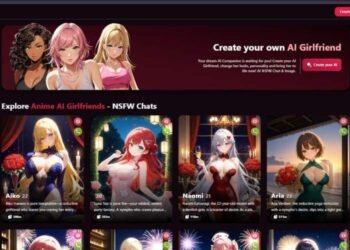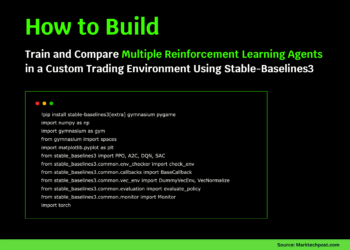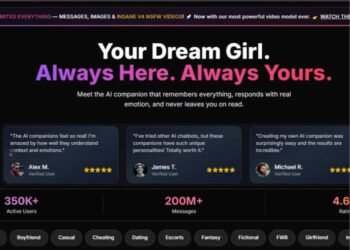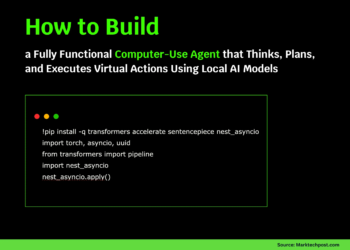In this tutorial, we present a complete end-to-end Natural Language Processing (NLP) pipeline built with Gensim and supporting libraries, designed to run seamlessly in Google Colab. It integrates multiple core techniques in modern NLP, including preprocessing, topic modeling with Latent Dirichlet Allocation (LDA), word embeddings with Word2Vec, TF-IDF-based similarity analysis, and semantic search. The pipeline not only demonstrates how to train and evaluate these models but also showcases practical visualizations, advanced topic analysis, and document classification workflows. By combining statistical methods with machine learning approaches, the tutorial provides a comprehensive framework for understanding and experimenting with text data at scale. Check out the FULL CODES here.
!pip install --upgrade scipy==1.11.4
!pip install gensim==4.3.2 nltk wordcloud matplotlib seaborn pandas numpy scikit-learn
!pip install --upgrade setuptools
print("Please restart runtime after installation!")
print("Go to Runtime > Restart runtime, then run the next cell")
import numpy as np
import pandas as pd
import matplotlib.pyplot as plt
import seaborn as sns
from wordcloud import WordCloud
import warnings
warnings.filterwarnings('ignore')
from gensim import corpora, models, similarities
from gensim.models import Word2Vec, LdaModel, TfidfModel, CoherenceModel
from gensim.parsing.preprocessing import preprocess_string, strip_tags, strip_punctuation, strip_multiple_whitespaces, strip_numeric, remove_stopwords, strip_short
import nltk
nltk.download('punkt', quiet=True)
nltk.download('stopwords', quiet=True)
from nltk.corpus import stopwords
from nltk.tokenize import word_tokenizeWe install and upgrade the necessary libraries, such as SciPy, Gensim, NLTK, and visualization tools, to ensure compatibility. We then import all required modules for preprocessing, modeling, and analysis. We also download NLTK resources to tokenize and handle stopwords efficiently, thereby setting up the environment for our NLP pipeline. Check out the FULL CODES here.
class AdvancedGensimPipeline:
def __init__(self):
self.dictionary = None
self.corpus = None
self.lda_model = None
self.word2vec_model = None
self.tfidf_model = None
self.similarity_index = None
self.processed_docs = None
def create_sample_corpus(self):
"""Create a diverse sample corpus for demonstration"""
documents = [ "Data science combines statistics, programming, and domain expertise to extract insights",
"Big data analytics helps organizations make data-driven decisions at scale",
"Cloud computing provides scalable infrastructure for modern applications and services",
"Cybersecurity protects digital systems from threats and unauthorized access attempts",
"Software engineering practices ensure reliable and maintainable code development",
"Database management systems store and organize large amounts of structured information",
"Python programming language is widely used for data analysis and machine learning",
"Statistical modeling helps identify patterns and relationships in complex datasets",
"Cross-validation techniques ensure robust model performance evaluation and selection",
"Recommendation systems suggest relevant items based on user preferences and behavior",
"Text mining extracts valuable insights from unstructured textual data sources",
"Image classification assigns predefined categories to visual content automatically",
"Reinforcement learning trains agents through interaction with dynamic environments"
]
return documents
def preprocess_documents(self, documents):
"""Advanced document preprocessing using Gensim filters"""
print("Preprocessing documents...")
CUSTOM_FILTERS = [
strip_tags, strip_punctuation, strip_multiple_whitespaces,
strip_numeric, remove_stopwords, strip_short, lambda x: x.lower()
]
processed_docs = []
for doc in documents:
processed = preprocess_string(doc, CUSTOM_FILTERS)
stop_words = set(stopwords.words('english'))
processed = [word for word in processed if word not in stop_words and len(word) > 2]
processed_docs.append(processed)
self.processed_docs = processed_docs
print(f"Processed {len(processed_docs)} documents")
return processed_docs
def create_dictionary_and_corpus(self):
"""Create Gensim dictionary and corpus"""
print("Creating dictionary and corpus...")
self.dictionary = corpora.Dictionary(self.processed_docs)
self.dictionary.filter_extremes(no_below=2, no_above=0.8)
self.corpus = [self.dictionary.doc2bow(doc) for doc in self.processed_docs]
print(f"Dictionary size: {len(self.dictionary)}")
print(f"Corpus size: {len(self.corpus)}")
def train_word2vec_model(self):
"""Train Word2Vec model for word embeddings"""
print("Training Word2Vec model...")
self.word2vec_model = Word2Vec(
sentences=self.processed_docs,
vector_size=100,
window=5,
min_count=2,
workers=4,
epochs=50
)
print("Word2Vec model trained successfully")
def analyze_word_similarities(self):
"""Analyze word similarities using Word2Vec"""
print("\n=== Word2Vec Similarity Analysis ===")
test_words = ['machine', 'data', 'learning', 'computer']
for word in test_words:
if word in self.word2vec_model.wv:
similar_words = self.word2vec_model.wv.most_similar(word, topn=3)
print(f"Words similar to '{word}': {similar_words}")
try:
if all(w in self.word2vec_model.wv for w in ['machine', 'computer', 'data']):
analogy = self.word2vec_model.wv.most_similar(
positive=['computer', 'data'],
negative=['machine'],
topn=1
)
print(f"Analogy result: {analogy}")
except:
print("Not enough vocabulary for complex analogies")
def train_lda_model(self, num_topics=5):
"""Train LDA topic model"""
print(f"Training LDA model with {num_topics} topics...")
self.lda_model = LdaModel(
corpus=self.corpus,
id2word=self.dictionary,
num_topics=num_topics,
random_state=42,
passes=10,
alpha="auto",
per_word_topics=True,
eval_every=None
)
print("LDA model trained successfully")
def evaluate_topic_coherence(self):
"""Evaluate topic model coherence"""
print("Evaluating topic coherence...")
coherence_model = CoherenceModel(
model=self.lda_model,
texts=self.processed_docs,
dictionary=self.dictionary,
coherence="c_v"
)
coherence_score = coherence_model.get_coherence()
print(f"Topic Coherence Score: {coherence_score:.4f}")
return coherence_score
def display_topics(self):
"""Display discovered topics"""
print("\n=== Discovered Topics ===")
topics = self.lda_model.print_topics(num_words=8)
for idx, topic in enumerate(topics):
print(f"Topic {idx}: {topic[1]}")
def create_tfidf_model(self):
"""Create TF-IDF model for document similarity"""
print("Creating TF-IDF model...")
self.tfidf_model = TfidfModel(self.corpus)
corpus_tfidf = self.tfidf_model[self.corpus]
self.similarity_index = similarities.MatrixSimilarity(corpus_tfidf)
print("TF-IDF model and similarity index created")
def find_similar_documents(self, query_doc_idx=0):
"""Find documents similar to a query document"""
print(f"\n=== Document Similarity Analysis ===")
query_doc_tfidf = self.tfidf_model[self.corpus[query_doc_idx]]
similarities_scores = self.similarity_index[query_doc_tfidf]
sorted_similarities = sorted(enumerate(similarities_scores), key=lambda x: x[1], reverse=True)
print(f"Documents most similar to document {query_doc_idx}:")
for doc_idx, similarity in sorted_similarities[:5]:
print(f"Doc {doc_idx}: {similarity:.4f}")
def visualize_topics(self):
"""Create visualizations for topic analysis"""
print("Creating topic visualizations...")
doc_topic_matrix = []
for doc_bow in self.corpus:
doc_topics = dict(self.lda_model.get_document_topics(doc_bow, minimum_probability=0))
topic_vec = [doc_topics.get(i, 0) for i in range(self.lda_model.num_topics)]
doc_topic_matrix.append(topic_vec)
doc_topic_df = pd.DataFrame(doc_topic_matrix, columns=[f'Topic_{i}' for i in range(self.lda_model.num_topics)])
plt.figure(figsize=(12, 8))
sns.heatmap(doc_topic_df.T, annot=True, cmap='Blues', fmt=".2f")
plt.title('Document-Topic Distribution Heatmap')
plt.xlabel('Documents')
plt.ylabel('Topics')
plt.tight_layout()
plt.show()
fig, axes = plt.subplots(2, 3, figsize=(15, 10))
axes = axes.flatten()
for topic_id in range(min(6, self.lda_model.num_topics)):
topic_words = dict(self.lda_model.show_topic(topic_id, topn=20))
wordcloud = WordCloud(
width=300, height=200,
background_color="white",
colormap='viridis'
).generate_from_frequencies(topic_words)
axes[topic_id].imshow(wordcloud, interpolation='bilinear')
axes[topic_id].set_title(f'Topic {topic_id}')
axes[topic_id].axis('off')
for i in range(self.lda_model.num_topics, 6):
axes[i].axis('off')
plt.tight_layout()
plt.show()
def advanced_topic_analysis(self):
"""Perform advanced topic analysis"""
print("\n=== Advanced Topic Analysis ===")
topic_distributions = []
for i, doc_bow in enumerate(self.corpus):
doc_topics = self.lda_model.get_document_topics(doc_bow)
dominant_topic = max(doc_topics, key=lambda x: x[1]) if doc_topics else (0, 0)
topic_distributions.append({
'doc_id': i,
'dominant_topic': dominant_topic[0],
'topic_probability': dominant_topic[1]
})
topic_df = pd.DataFrame(topic_distributions)
plt.figure(figsize=(10, 6))
topic_counts = topic_df['dominant_topic'].value_counts().sort_index()
plt.bar(range(len(topic_counts)), topic_counts.values)
plt.xlabel('Topic ID')
plt.ylabel('Number of Documents')
plt.title('Distribution of Dominant Topics Across Documents')
plt.xticks(range(len(topic_counts)), [f'Topic {i}' for i in topic_counts.index])
plt.show()
return topic_df
def document_classification_demo(self, new_document):
"""Classify a new document using trained models"""
print(f"\n=== Document Classification Demo ===")
print(f"Classifying: '{new_document[:50]}...'")
processed_new = preprocess_string(new_document, [
strip_tags, strip_punctuation, strip_multiple_whitespaces,
strip_numeric, remove_stopwords, strip_short, lambda x: x.lower()
])
new_doc_bow = self.dictionary.doc2bow(processed_new)
doc_topics = self.lda_model.get_document_topics(new_doc_bow)
print("Topic probabilities:")
for topic_id, prob in doc_topics:
print(f" Topic {topic_id}: {prob:.4f}")
new_doc_tfidf = self.tfidf_model[new_doc_bow]
similarities_scores = self.similarity_index[new_doc_tfidf]
most_similar = np.argmax(similarities_scores)
print(f"Most similar document: {most_similar} (similarity: {similarities_scores[most_similar]:.4f})")
return doc_topics, most_similar
def run_complete_pipeline(self):
"""Execute the complete NLP pipeline"""
print("=== Advanced Gensim NLP Pipeline ===\n")
raw_documents = self.create_sample_corpus()
self.preprocess_documents(raw_documents)
self.create_dictionary_and_corpus()
self.train_word2vec_model()
self.train_lda_model(num_topics=5)
self.create_tfidf_model()
self.analyze_word_similarities()
coherence_score = self.evaluate_topic_coherence()
self.display_topics()
self.visualize_topics()
topic_df = self.advanced_topic_analysis()
self.find_similar_documents(query_doc_idx=0)
new_doc = "Deep neural networks are powerful machine learning models for pattern recognition"
self.document_classification_demo(new_doc)
return {
'coherence_score': coherence_score,
'topic_distributions': topic_df,
'models': {
'lda': self.lda_model,
'word2vec': self.word2vec_model,
'tfidf': self.tfidf_model
}
}We define the AdvancedGensimPipeline class as a modular framework to handle every stage of text analysis in one place. It starts with creating a sample corpus, preprocessing it, and then building a dictionary and corpus representations. We train Word2Vec for embeddings, LDA for topic modeling, and TF-IDF for similarity, followed by visualization, coherence evaluation, and classification of new documents. This way, we bring together the complete NLP workflow, from raw text to insights, into a single reusable pipeline. Check out the FULL CODES here.
def compare_topic_models(pipeline, topic_range=[3, 5, 7, 10]):
print("\n=== Topic Model Comparison ===")
coherence_scores = []
perplexity_scores = []
for num_topics in topic_range:
lda_temp = LdaModel(
corpus=pipeline.corpus,
id2word=pipeline.dictionary,
num_topics=num_topics,
random_state=42,
passes=10,
alpha="auto"
)
coherence_model = CoherenceModel(
model=lda_temp,
texts=pipeline.processed_docs,
dictionary=pipeline.dictionary,
coherence="c_v"
)
coherence = coherence_model.get_coherence()
coherence_scores.append(coherence)
perplexity = lda_temp.log_perplexity(pipeline.corpus)
perplexity_scores.append(perplexity)
print(f"Topics: {num_topics}, Coherence: {coherence:.4f}, Perplexity: {perplexity:.4f}")
fig, (ax1, ax2) = plt.subplots(1, 2, figsize=(15, 5))
ax1.plot(topic_range, coherence_scores, 'bo-')
ax1.set_xlabel('Number of Topics')
ax1.set_ylabel('Coherence Score')
ax1.set_title('Model Coherence vs Number of Topics')
ax1.grid(True)
ax2.plot(topic_range, perplexity_scores, 'ro-')
ax2.set_xlabel('Number of Topics')
ax2.set_ylabel('Perplexity')
ax2.set_title('Model Perplexity vs Number of Topics')
ax2.grid(True)
plt.tight_layout()
plt.show()
return coherence_scores, perplexity_scoresThis function compare_topic_models lets us systematically test different numbers of topics for the LDA model and compare their performance. We calculate coherence scores (to check topic interpretability) and perplexity scores (to check model fit) for each topic count in the given range. The results are displayed as line plots, helping us visually decide the most balanced number of topics for our dataset. Check out the FULL CODES here.
def semantic_search_engine(pipeline, query, top_k=5):
"""Implement semantic search using trained models"""
print(f"\n=== Semantic Search: '{query}' ===")
processed_query = preprocess_string(query, [
strip_tags, strip_punctuation, strip_multiple_whitespaces,
strip_numeric, remove_stopwords, strip_short, lambda x: x.lower()
])
query_bow = pipeline.dictionary.doc2bow(processed_query)
query_tfidf = pipeline.tfidf_model[query_bow]
similarities_scores = pipeline.similarity_index[query_tfidf]
top_indices = np.argsort(similarities_scores)[::-1][:top_k]
print("Top matching documents:")
for i, idx in enumerate(top_indices):
score = similarities_scores[idx]
print(f"{i+1}. Document {idx} (Score: {score:.4f})")
print(f" Content: {' '.join(pipeline.processed_docs[idx][:10])}...")
return top_indices, similarities_scores[top_indices]The semantic_search_engine function adds a search layer to the pipeline by taking a query, preprocessing it, and converting it into a bag-of-words and TF-IDF representations. It then compares the query against all documents using the similarity index and returns the top matches. This way, we can quickly retrieve the most relevant documents along with their similarity scores, making the pipeline useful for practical information retrieval and semantic search tasks. Check out the FULL CODES here.
if __name__ == "__main__":
pipeline = AdvancedGensimPipeline()
results = pipeline.run_complete_pipeline()
print("\n" + "="*60)
coherence_scores, perplexity_scores = compare_topic_models(pipeline)
print("\n" + "="*60)
search_results = semantic_search_engine(
pipeline,
"artificial intelligence neural networks deep learning"
)
print("\n" + "="*60)
print("Pipeline completed successfully!")
print(f"Final coherence score: {results['coherence_score']:.4f}")
print(f"Vocabulary size: {len(pipeline.dictionary)}")
print(f"Word2Vec model size: {pipeline.word2vec_model.wv.vector_size} dimensions")
print("\nModels trained and ready for use!")
print("Access models via: pipeline.lda_model, pipeline.word2vec_model, pipeline.tfidf_model")This main block ties everything together into a complete, executable pipeline. We initialize the AdvancedGensimPipeline, run the full workflow, and then evaluate topic models with different numbers of topics. Next, we test the semantic search engine with a query about artificial intelligence and deep learning. Finally, it prints out summary metrics, such as the coherence score, vocabulary size, and Word2Vec embedding dimensions, confirming that all models are trained and ready for further use.
In conclusion, we gain a powerful, modular workflow that covers the entire spectrum of text analysis, from cleaning and preprocessing raw documents to discovering hidden topics, visualizing results, comparing models, and performing semantic search. The inclusion of Word2Vec embeddings, TF-IDF similarity, and coherence evaluation ensures that the pipeline is both versatile and robust, while visualizations and classification demos make the results interpretable and actionable. This cohesive design enables learners, researchers, and practitioners to quickly adapt the framework for real-world applications, making it a valuable foundation for advanced NLP experimentation and production-ready text analytics.
Check out the FULL CODES here. Feel free to check out our GitHub Page for Tutorials, Codes and Notebooks. Also, feel free to follow us on Twitter and don’t forget to join our 100k+ ML SubReddit and Subscribe to our Newsletter.
Asif Razzaq is the CEO of Marktechpost Media Inc.. As a visionary entrepreneur and engineer, Asif is committed to harnessing the potential of Artificial Intelligence for social good. His most recent endeavor is the launch of an Artificial Intelligence Media Platform, Marktechpost, which stands out for its in-depth coverage of machine learning and deep learning news that is both technically sound and easily understandable by a wide audience. The platform boasts of over 2 million monthly views, illustrating its popularity among audiences.

















